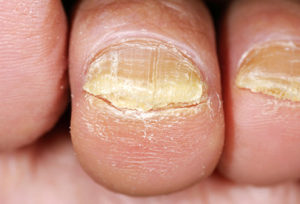

Nail fungus
Nail fungus is a common condition that begins as a white or yellow spot under the tip of your fingernail or toenail. As the fungal infection goes deeper, nail fungus may cause your nail to discolor, thicken and crumble at the edge. It can affect several nails, the big toenails are often affected. Nail fungus is less common on the fingernails.
Fungal nail infections are hard to get rid of. Because our toenails only grow slowly, treatment generally takes a long time and requires patience. It can take several months to work.
If your condition is mild and not bothering you, you may not need treatment. If your nail fungus is painful and has caused thickened nails, self-care steps and medications may help. But even if treatment is successful, nail fungus often comes back.
Causes
Fungal nail infections are caused by various fungal organisms (fungi). The most common cause is a type of fungus called dermatophyte. The most common etiologic dermatophytes are Trichophyton rubrum and T.mentagrophytes.
Fungal nail infection can develop in people at any age, but it’s more common in older adults. As the nail ages, it can become brittle and dry. The resulting cracks in the nails allow fungi to enter. Other factors — such as reduced blood circulation to the feet and a weakened immune system — also may play a role.
Risk factors
Factors that can increase your risk of developing nail fungus include:
- Being older, owing to reduced blood flow, more years of exposure to fungi and slower growing nails
- Sweating heavily
- Having a history of athlete’s foot
- Walking barefoot in damp communal areas, such as swimming pools, gyms and shower rooms
- Having a minor skin or nail injury or a skin condition, such as psoriasis
- Having diabetes, circulation problems or a weakened immune system
Symptoms
The onset of nail fungus is slow and insidious. The condition is often asymptomatic, but it can also cause pain in the affected toe/finger, nail-trimming problems and discomfort when wearing shoes.
You may have nail fungus if one or more of your nails are:
- Thickened
- Whitish to yellow-brown discoloration
- White patches to form on the surface of the nail
- Brittle, crumbly or ragged
- Distorted in shape
- A dark color, caused by debris building up under your nail
- Smelling slightly foul
When to see a doctor
.jpg)
You may want to see a physician if self-care steps haven’t helped and the nail becomes increasingly discolored, thickened or deformed. Also see a doctor if you have diabetes and think you’re developing nail fungus.
Prevention
- Keep your hands and feet clean and dry.
- Wash your hands after touching an infected nail.
- Trim nails straight across, smooth the edges with a file and file down thickened areas. Disinfect your nail clippers after each use.
- Wear sweat-absorbing socks or change your socks throughout the day.
- Choose shoes made of materials that breathe.
- Discard old shoes or treat them with disinfectants or antifungal powders.
- Wear footwear in pool areas and locker rooms.
- Choose a nail salon that uses sterilized manicure tools for each customer.
- Give up nail polish and artificial nails